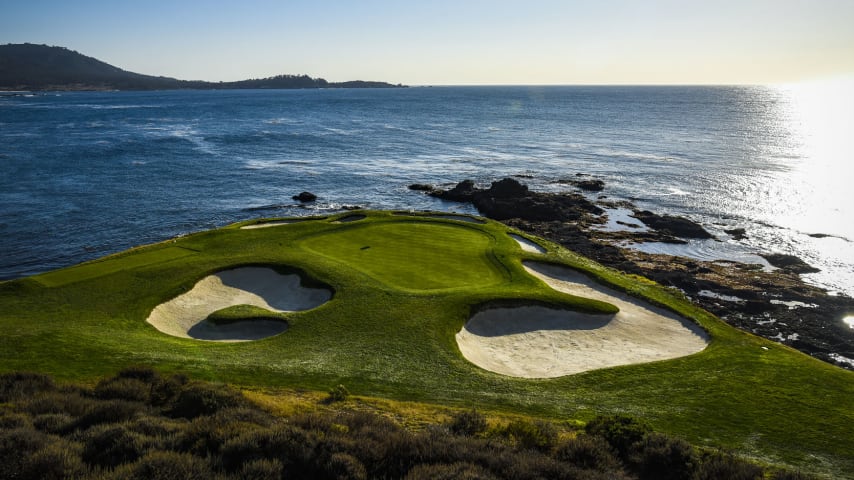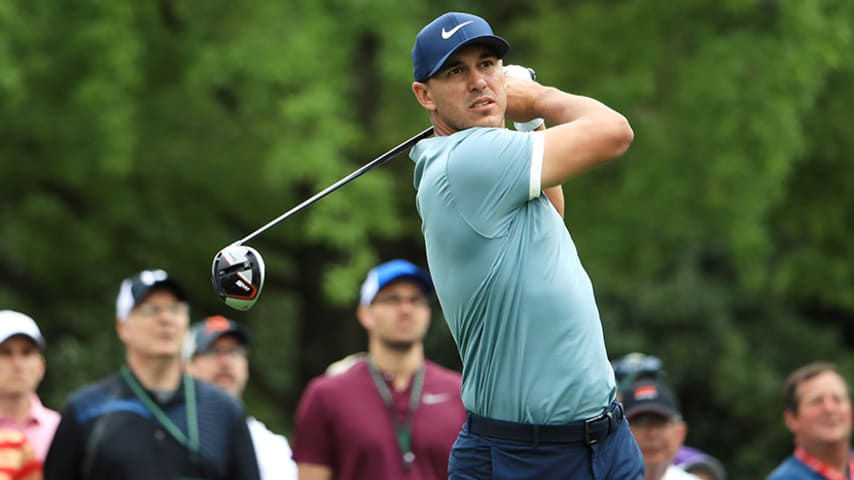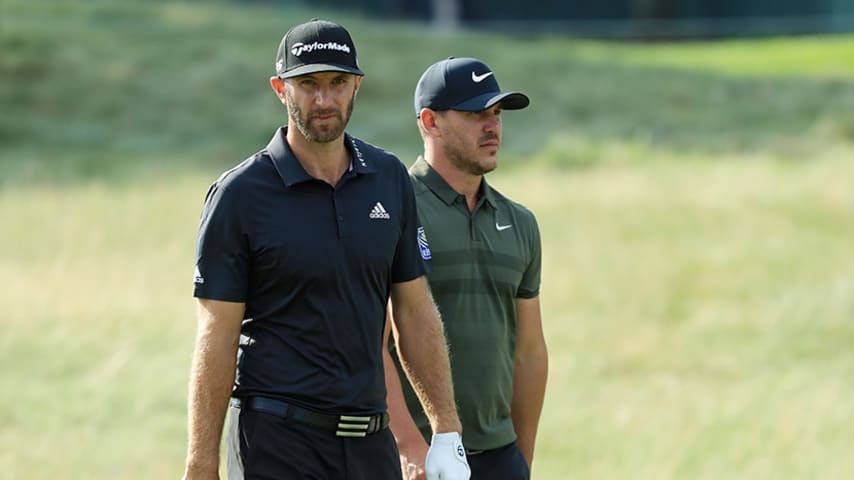Nine Things to Know: Pebble Beach Golf Links
13 Min Read

PEBBLE BEACH, CA - NOV 08: Course previews for the AT&T Pebble Beach Pro-Am and 2019 U.S. Open at Pebble Beach Golf Links on November 8, 2018 in Pebble Beach, California. (Photo by Keyur Khamar/PGA TOUR)
Historic and iconic course will be the venue this week for the U.S. Open
Written by Sean Martin
Historic and iconic course will be the venue this week for the U.S. Open
The U.S. Open returns to one of golf’s iconic locations this week. This will be the sixth U.S. Open conducted on Pebble Beach Golf Links, a course known for its beautiful scenery and stiff challenge. It may be short by today’s standards, but small greens and high winds still provide plenty of challenge. Tiger Woods is the only player to finish under par in the past two U.S. Opens at Pebble Beach, and he did it with the greatest performance in the game’s history.
Here’s 9 Things to Know before play gets underway on the California’s Central Coast.
1. AN INAUSPICIOUS START
It’s impossible to fathom now, but the first attempt to construct the Pebble Beach Golf Links was unsuccessful. Twenty-five memberships for the new seaside course were sold for $25 apiece, according to Neal Hotelling’s official history of Pebble Beach. Nine temporary oil-and-sand-greens were built. In April 1910, the new course was advertised as “soon to open”. Ten members backed out, though, and the plans were scrapped. It was nearly a decade before golf was played at Pebble Beach.
Then the land that is now one of the world’s most famous courses was almost sold for housing lots, but Samuel Morse destroyed the plans and convinced the owners that the land would be better used as a golf course.
Morse hired two amateur architects, Jack Neville and Douglas Grant, designed Pebble Beach.
“The big idea was to get as many holes as possible along the bay,” Neville said. “Nature had intended it to be nothing else but a golf links.”
When it opened, Pebble Beach was simply referred to as the No. 2 course at Del Monte. The new seaside course was preceded by the inland Del Monte Golf Course, which opened in 1897, and was an attraction for the well-heeled guests of the Del Monte Hotel.
Though the centennial of Pebble Beach is celebrated this year, the course was first played the previous year.
Only one man, Mike Brady of Massachusetts, finished within 20 shots of par in the 36-hole tournament that marked the course’s unveiling. Brady, the runner-up at the 1911 and 1919 U.S. Opens, shot 79-75 to win by 13 shots.
“The critiques on the opening day included lack of turf, rock-infested fairways and indentations on the greens from the sheep employed to maintain the grounds,” Hotelling wrote.
The San Francisco Chronicle said the course was opened “somewhat prematurely.” At a time when golf balls cost more than the greens fee, the course was deemed too difficult. One newspaper called the course “a conspiracy to make necessary the purchase of large quantities of golf balls.”
It was closed for nearly a year until being re-opened on Washington’s Birthday in 1919.
To mark the birth of the country’s first president, a cherry tree was planted in front of the Lodge at Pebble Beach. All golfers present that day took an oath swearing to turn in honest scorecards. The course and lodge were built for a reported cost of $200,000.
2. SHORT STUFF
Pebble Beach will play 7,075 yards for the U.S. Open. Since 2010, only one U.S. Open venue has been shorter (Merion, 2013).
Pebble Beach still provides a stiff challenge, though. The average winning score in U.S. Opens at Pebble Beach is 282.6 strokes (the course has played as a par-71 in the past two U.S. Opens). The legendary sportswriter Jim Murray called the course “7,000 yards of malice.”
“It’s a more strategic golf course than people give it credit for,” said Golf Channel analyst Arron Oberholser, who won the 2006 AT&T Pebble Beach Pro-Am. “People think you can just bludgeon it because it’s barely 7,000 yards, that it’s a pitch and putt, but you have to give yourself the right angles.
“You have to be very strategic on where you attack and when you attack. You have to know your outs. Knowing where to leave it is massive. People look at the greens and think they’re just tilted (back-to-front), but you miss a couple in the wrong spots and you have nothing.”
The June date virtually guarantees a firm and fast golf course. And the seaside locale means wind will be a factor.
“Pebble Beach without any wind is not a very hard golf course,” said Jack Nicklaus. “But you never find it without any wind.”
Scores can soar when the wind blows especially hard. That’s what happened in the final round of the 1972 and 1992 U.S. Opens, when the scoring average was 78.8 and 77.3, respectively.
Eight of the final 14 players to tee off in 1992 shot 80 or higher. Scott Simpson shot 68-88 in the final two rounds. Mark Brooks shot an 84 on Sunday after starting the final round in second place.
Jeff Sluman, the runner-up in 1992, said the final round was “as much fun as a migraine.”
3. TARGET PRACTICE
Combine the conditions with the smallest greens on the PGA TOUR and it’s easy to see how Pebble Beach combines such a challenge.
The field hit 52% of the greens in regulation at the last U.S. Open at Pebble Beach. They hit less than half in 2000 (48%). A course hasn’t had a lower GIR percentage since then.
Before the last U.S. Open at Pebble Beach, the USGA’s Mike Davis called Pebble Beach’s greens, “the scariest greens we’ve had for a U.S. Open.
“So many of these greens have a lot of pitch from back-to-front or side-to-side, and they’re small,” Davis said. “That (green) speed is a very scary speed if you short-side yourself or get on the wrong side of the hole.”
Oberholser said only Oakmont and Winged Foot have more back-to-front tilt than Pebble Beach. “You’re starting 3-footers potentially a ball or two outside the hole,” he said.
Phil Mickelson, a five-time winner of the AT&T Pebble Beach Pro-Am, said in 2010 that there were several greens he’d miss intentionally.
“You cannot chip downhill, especially out of the rough with these greens,” he said. “(The greens) are so small and so hard that there are a couple that are virtually impossible to keep the ball on the surface.”
4. REWARDING GREATNESS
The list of champions at Pebble Beach proves that the course is more than just a pretty place. Many of the game’s greats, from Nicklaus to Watson to Woods, have won U.S. Opens at Pebble Beach.
Five of the six majors at Pebble Beach have been won by World Golf Hall of Famers (or those destined for enshrinement). Nicklaus (1972), Tom Watson (1982), Tom Kite (1992) and Tiger Woods (2000) all won U.S. Opens at Pebble Beach. The PGA Championship also visited Pebble Beach in 1977. Another Hall of Famer, Lanny Wadkins, was the champion.
“I’ve been enamored with the course since first setting eyes on it during a practice round of the U.S. Amateur,” said Nicklaus, who also won the 1961 U.S. Amateur at Pebble Beach. “It’s as dramatic as any course in the country, but mostly it was the complete test of golf that intrigued me.”
MAJORS AT PEBBLE BEACH
| Tournament | Winner | Score |
| 2010 U.S. Open | Graeme McDowell | 284 (E) |
| 2000 U.S. Open | Tiger Woods | 272 (-12) |
| 1992 U.S. Open | Tom Kite | 285 (-3) |
| 1982 U.S. Open | Tom Watson | 282 (-6) |
| 1977 PGA | Lanny Wadkins | 282 (-6) |
| 1972 U.S. Open | Jack Nicklaus | 290 (+2) |
5. THE BEST OF THE BEST
Nicklaus and Woods both won twice at Pebble Beach during the best seasons of their historic careers.
In 1972, Nicklaus tied career-highs with seven wins and two majors. It was the only time in his career that he won the first two majors of the year.
He started the season by beating Johnny Miller in a playoff at the AT&T Pebble Beach Pro-Am. Nicklaus returned four months later to win his third U.S. Open. He beat a star-studded leaderboard with a score of 290, the highest winning score at the U.S. Open since 1935. He clinched his win with arguably the most famous shot of his career, a 1-iron that one-hopped the flagstick on the par-3 17th.
Nicklaus had at least a share of the lead after every round. He started the fourth round with a one-shot lead over three players, including Lee Trevino. Miller and Arnold Palmer were just two shots back.
Nicklaus won by three with a final-round 74 in difficult conditions. Only one player broke par in the final round as the average score neared 79. It was his 13th major triumph, tying him with his boyhood idol, Bobby Jones.
“The course was playing as close to impossible as it can get,” Nicklaus said. “And skill in putting was practically eliminated.”
Nicklaus’ Grand Slam bid ended at The Open Championship, where he finished a stroke behind Trevino.
Woods replicated Nicklaus’ Pebble Beach double nearly three decades later. It started at the AT&T Pebble Beach Pro-Am, where Woods played the final four holes in 4 under, including a hole-out eagle on the par-4 15th, to win by two. He beat 54-hole leader Matt Gogel by nine strokes over the final eight holes.
Woods went on to win three majors that year, joining Ben Hogan (1953) as the only men to win three professional majors in a single season. It started with Woods’ masterpiece performance at the U.S. Open. Despite a triple-bogey (with no penalty strokes) in the third round, Woods went on to win by 15 shots. He led by six shots after 36 holes and took a 10-shot lead into the final round.
He broke Old Tom Morris’ record for largest victory margin in a major.
“If you put Old Tom Morris with Tiger Woods, he’d probably beat him by 80 shots right now,” said Ernie Els, who shared second place with Miguel Angel Jimenez. “Hey, the guy is unbelievable, man.”
Woods went on to win The Open Championship at St. Andrews by eight (also over Els), then won the PGA Championship in a playoff with Bob May.
Woods won a career-high nine times that season.
LARGEST WINNING MARGINS IN MAJORS*
| Margin | Player | Event |
| 15 | Tiger Woods | 2000 U.S. Open |
| 12 | Tiger Woods | 1997 Masters |
| 9 | Jack Nicklaus | 1965 Masters |
| 8 | Tiger Woods | 2000 Open |
| 8 | Rory McIlroy | 2011 U.S. Open |
| 8 | Rory McIlroy | 2012 PGA |
| 8 | Raymond Floyd | 1976 Masters |
| 8 | Martin Kaymer | 2014 U.S. Open |
* - since 1925
Woods has won five majors by at least five shots. He has at least one victory of five or more shots in each of the four majors (he did it twice at The Open Championship). Since World War I, no one else has won more than two majors by at least five strokes.
6. FRIENDLY WELCOME
Pebble Beach offers a (relatively) gentle opening stretch. There are two par-5s and three par-4s shorter than 410 yards in the opening third of the course.
That stretch plays slightly tougher in the U.S. Open because the 502-yard second hole is converted from a par-5 to a par-4, but it’s still important to start well. Throw in the 109-yard seventh, the shortest hole on the PGA TOUR, and competitors in the 2010 U.S. Open had faced five of Pebble Beach’s seven easiest holes before reaching the eighth tee.
That stretch included the four easiest holes on the course.
EASIEST HOLES IN 2010 U.S. OPEN
| Hole | Par/Yardage | Average |
| No. 6 | 523 yards, Par 5 | 4.65 |
| No. 4 | 331 yards, Par 4 | 3.92 |
| No. 7 | 109 yards, Par 3 | 3.06 |
| No. 3 | 404 yards, Par 4 | 4.11 |
7. SEASIDE STRETCH
After those opening holes, Pebble Beach quickly hits players with three of the greatest par-4s found anywhere.
It starts with the eighth hole, which Nicklaus called it the “finest second shot in golf.” Woods said it was one of the most daunting approach shots in the game.
Players hit a blind tee shot to a fairway that’s some 10 stories above the ocean. The approach shot must sail over the cliffs to a small, severely-sloped green that sits below the golfer.
Next up are the ninth and 10th holes, which combine to measure more than 1,000 yards. Both feature fairways that slope toward the ocean. A drive down the right side, near the beach, offers the best angle to both greens. Bunkers protect the left side of both putting surfaces, and the ocean isn’t far from the right side. Players must hit their approach with the ball laying below their feet.
A new tee will stretch the ninth hole to 526 yards. The added length will keep players from reaching a downslope that could propel their balls closer to the green. Players hit the ninth green just 41% of the time in 2010.
The 10th hole, which will serve as each player’s starting hole during one of the first two rounds, is 495 yards. It’s the widest fairway on the course, but also severely tilted toward the water.
“People are starting to understand how good these holes are,” golf-course architect Tom Doak wrote. “That’s what you remember after playing the course the first time, not 17 and 18. If 8, 9 and 10 were the closing holes, it would be the most famous finish in golf.”
NOS. 8-10 IN 2010
| Hole Yardage | Average | Greens hit % |
| No. 8, 428 yards | 4.30 | 41% |
| No. 9, 505 yards | 4.39 | 41% |
| No. 10, 495 yards | 4.41 | 49% |
8. NO BARGAIN
Par-5s are supposed to be birdie opportunities, but that’s not the case on Pebble Beach’s back nine.
The 14th hole runs uphill, away from the water, and doglegs right. The 18th hole turns to the left as it hugs Stillwater Cove. They’re two very different holes but both offer a challenge not normally found on three-shot holes.
The 14th green was designed by local artist Francis McComas, who also was an avid golfer. To give the long, uphill hole a unique flair, McComas created a two-tiered green settled among overhanging oaks. A large bunker protects the upper tier on the left. His creation is one of the most recognizable greens at Pebble Beach.
It also is one of the most difficult. The 14th annually ranks as one of the toughest par-5s on the PGA TOUR. It was the third-hardest hole in the 2010 U.S. Open, playing to a 5.44 scoring average. That’s the highest scoring average on a par-5 on the entire PGA TOUR since 2000.
Pebble Beach’s 543-yard final hole is one of the most famous in golf. It is a dramatic par-5 that dares players to flirt with Stillwater Cove. That wasn’t always the case.
It started as a 325-yard, par-4 that was once deemed a “woefully poor finishing hole.” To add some intrigue to the 18th hole, a new tee was built on the rocks behind the 17th green. It added 35 yards to the hole and forced players to carry the cove.
The hole finally became a par-5 in 1922, after a creek behind the green was culverted. This allowed the green to be moved 170 yards down the coast.
9. ANNUAL VISIT
The PGA TOUR visits Pebble Beach each year, of course, for the AT&T Pebble Beach Pro-Am. Four of the five players who won a U.S. Open at Pebble Beach had previously won the annual PGA TOUR stop there. Players can only glean so much information from their trips to the tournament once known as the Crosby Clambake, though.
PLAYERS TO WIN U.S. OPEN AT PEBBLE BEACH AND AT&T PEBBLE BEACH PRO-AM
| Name | U.S. Open win | AT&T Pebble Beach |
| Tiger Woods | 2000 | 2000 |
| Tom Kite | 1992 | 1983 |
| Tom Watson | 1982 | 1977, 1978 |
| Jack Nicklaus | 1972 | 1967, 1972, 1973 |
Mickelson won his fifth AT&T Pebble Beach Pro-Am this year, tying him with Mark O’Meara for the most wins in the tournament’s history. That success won’t mean much this week.
“There’s really no carry-over, other than I just really enjoy this place,” Mickelson said. “I seem to play some of my best golf here and that’s probably about it.”
Nicklaus, who won the AT&T Pebble Beach Pro-Am three times, concurs.
“When they play it in June, it could be like a rock,” Nicklaus said. “A lot of guys think because they come here and play it at the AT&T that they’re going to have experience on how this golf course plays.
“I’ve never seen many rounds at the AT&T that give you much experience for what we’re getting (at the U.S. Open).”






